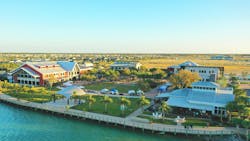In 2018, I wrote about Florida's Babcock Ranch, at the time a relatively new community being billed as “the world's first solar-powered town."
Located on Florida’s west coast, Babcock Ranch was being developed as a sustainable – and hurricane-resistant – community on 18,000 acres of a former ranch, of which 9,000 acres were to be preserved as green space. To avoid storm surge during a hurricane, the town was located inland, approximately 15 miles northeast of Fort Myers. And since electric power, whether from the grid or the nearby solar farm, needs infrastructure to deliver it, all of Babcock Ranch's power lines were built underground to protect them from windstorms. Large retainage ponds were also built and the streets were designed to absorb floodwater.
Since the town was in its very early stages of development in 2018, I thought a return visit, four years later, might be in order. During that visit, I learned that the handful of residents when I first visited had grown to a population of nearly 6,000. Not surprisingly, one of the residents is Syd Kittson, the developer of Babcock Ranch (some of you may remember him as a guard with the NFL's Packers and Cowboys in the 1980s). Kittson has a home there and is in residence several days a week. Much more surprising is the fact the number of his neighbors at Babcock Ranch actually doubled during the pandemic!
Toughest Test to Date
The sustainability of Babcock Ranch was undeniable from the start, but the hurricane resistance had yet to be proven. Several months after my second visit, that test came in the form of Hurricane Ian. Since the homes were constructed to exceed hurricane codes, most residents opted to not evacuate, and the community experienced virtually no damage: a few street signs and trees were knocked down by the 100 mph winds, but the town never lost power and all of the roofs were still there.
But then came Hurricanes Helene and Milton, which wreaked epic damage across the Southeast this fall. They prompted me to check back in with Babcock Ranch to see how it had fared. \
Although the Fort Myers area did not take a direct hit from Hurricane Helene, there was storm surge, flooding, sand on the roads, and power outages, none of which affected Babcock Ranch. Hurricane Milton was a different story. Coming just two weeks later, it made landfall approximately 80 miles north of Fort Myers and the storm surge caused major flooding and pushed a lot more sand off of the beach.
Many Fort Myers residents, who were under an evacuation order, actually sought safety at Babcock Ranch. In fact, more than 2,000 people sheltered in Babcock Ranch’s school and sports facility, with hundreds more finding refuge in private homes after Gov. Ron DeSantis had announced that the town was opening its doors to evacuees.
Although thousands of Fort Myers residences lost power, the lights stayed on in Babcock Ranch. Reported damage there included some downed trees, traffic lights, and the sunshades over the EV charging stations.
But Babcock Ranch isn’t the only sustainable community in Florida to survive unscathed by Milton.
Hunters Point, located nearly 100 miles north of Babcock Ranch and nearly an hour south of Tampa Bay, had solar-powered batteries still operating its 31 luxury homes four days after the storm hit, which had knocked out power to virtually everyone else in the entire region.
When I heard about Hunters Point, I reached out to them and learned that it is the first single-family net-zero community in the United States. All of the homes are powered by solar PV and have battery storage systems. Its high-end homes are built 16 feet above sea level and are constructed of sustainable materials.
Look for a more in-depth profile of Hunters Point after I have a chance to visit… but not until the end of the Atlantic hurricane season! In the meantime, it may be appropriate for us to start thinking of sustainability not just in terms of saving energy, but also saving lives.
##########
